Tag: squirrel
Squirrel Siblings
This is Baby Grey and Baby Brin. Not babies anymore!
Today’s back yard hangout with a friend
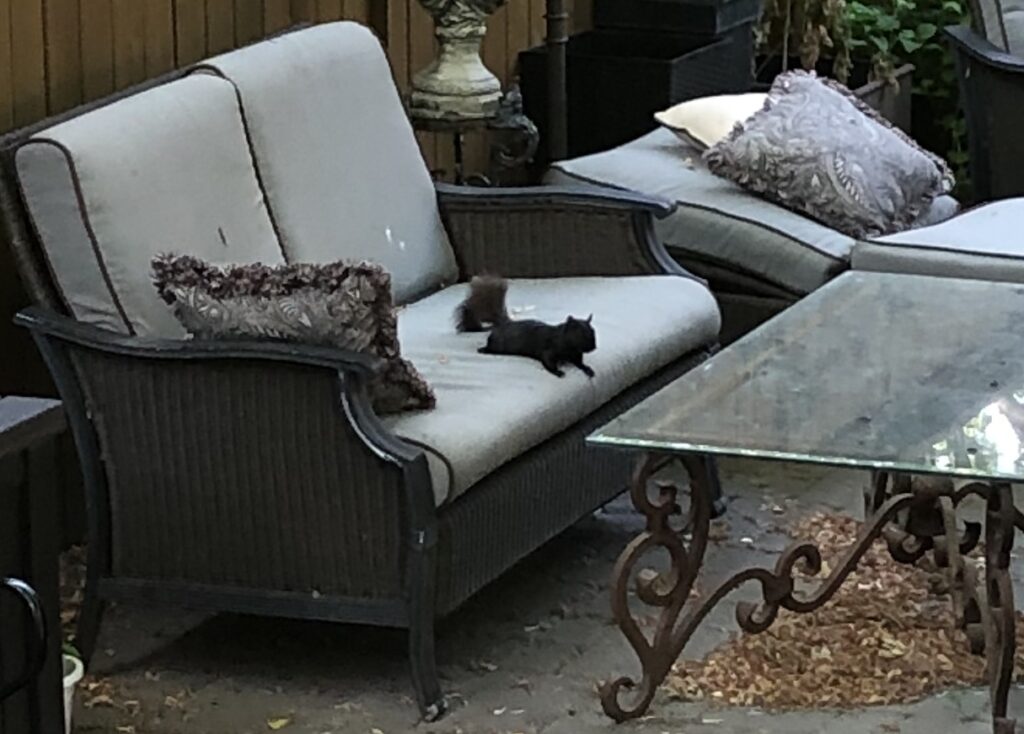
Today’s small joy: A physically distanced back yard hangout with a friend. Whose back yard it is might be a matter of perspective … I tend to think of it as ‘our’…
Today’s small joy: a little (mischievous) friend
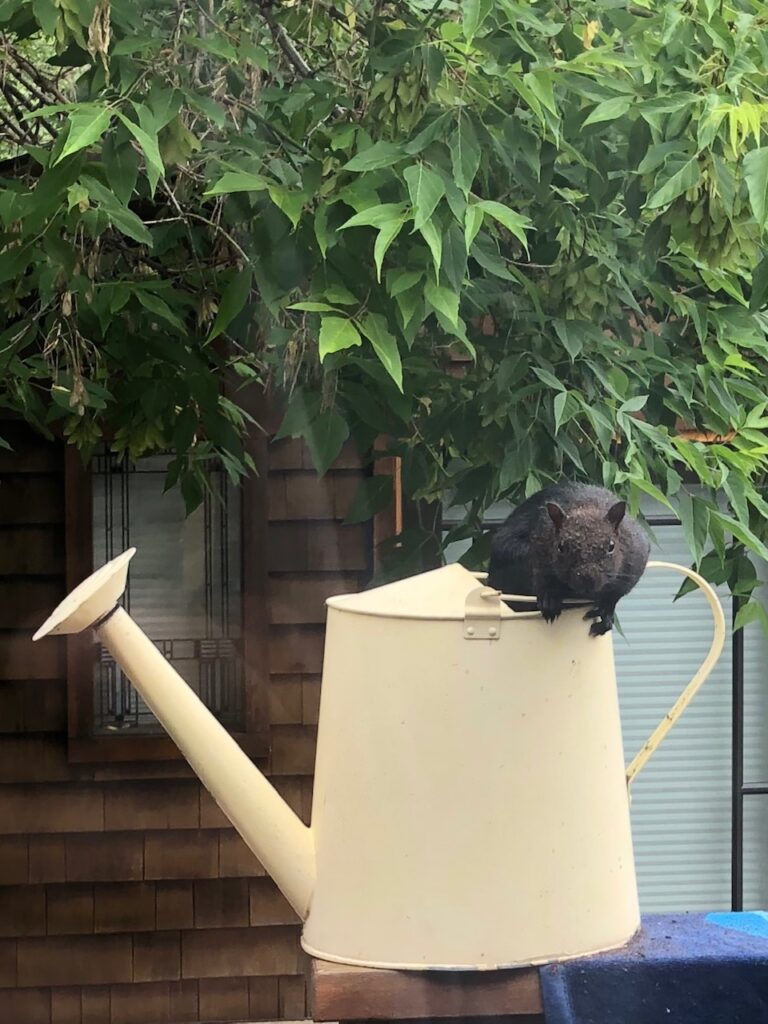
Today’s small joy: a little (mischievous) friend to greet me as I came outside for my early morning write
Meet Greysie. Master of Cuteness.
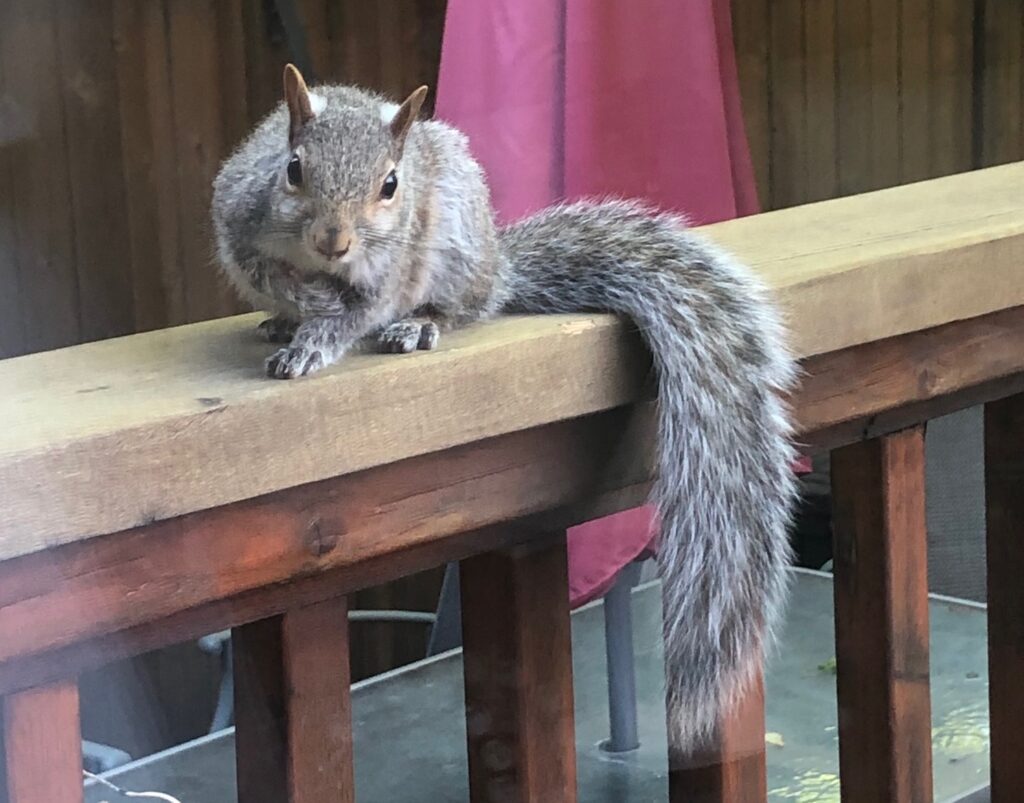
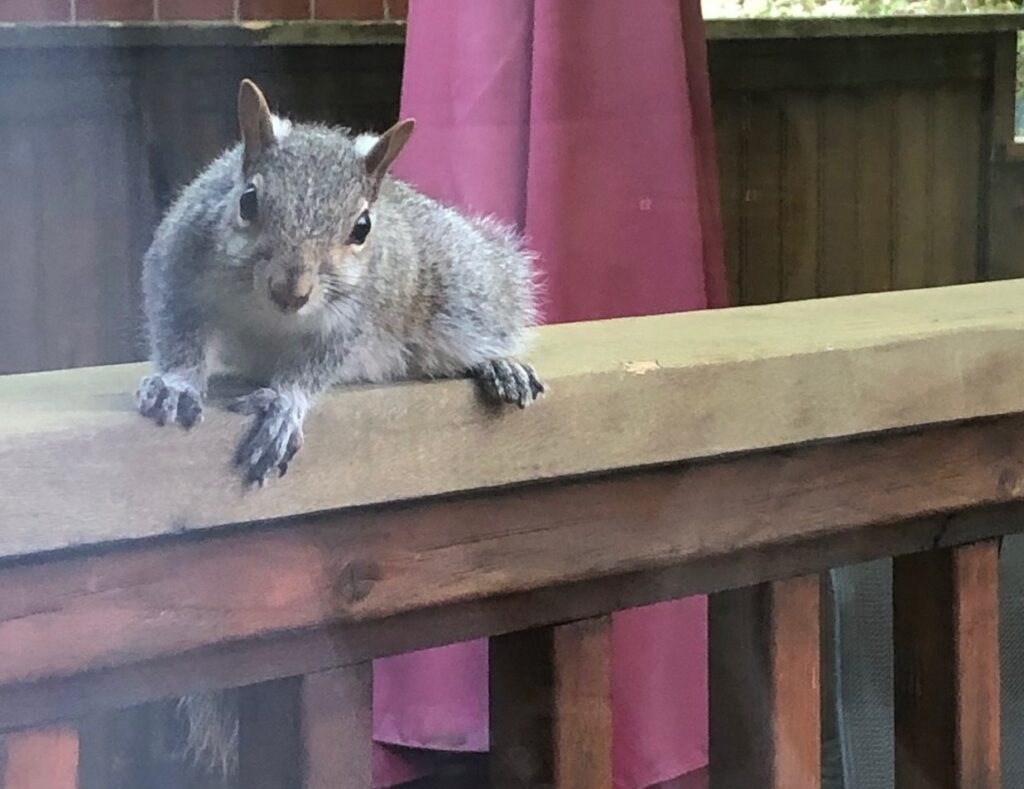
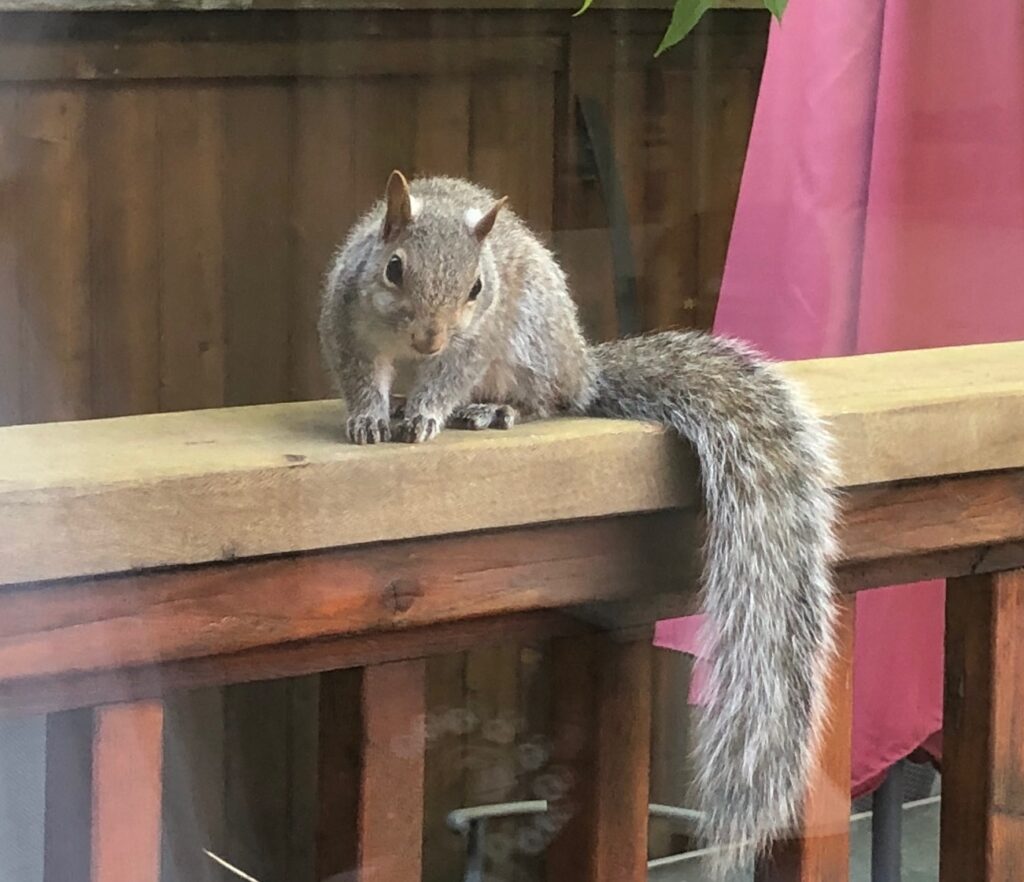
This beauty is little Greysie May. She is a frequent visitor to my back yard. Greysie is a little more timid in her leaps and scampers than the other squirrels. I suspect because she is smaller. And she’s not always the most on the ball, really. But she is a fantastic model, as you can see.
I can tell Greysie May apart from the other grey squirrels thanks to the adorable white stripes of fur behind her ears. What looks like little white tufts are actually small stripes. And she is more white-grey than Baby Grey (her sibling) or Gradie, my other grey squirrel neighbour, who both have more auburn colouring in his fur.
Little Graysie is one of Mimi’s babies.
I first discovered that her sibling, Baby Grey, was one of Mimi’s babies because Mimi would allow Baby Grey to climb on and around her. Then I saw that Baby Brin was one of Mimi’s as well. And finally, the last to come to my home – and the last I realized was one of the family – is this beautiful little Greysie.
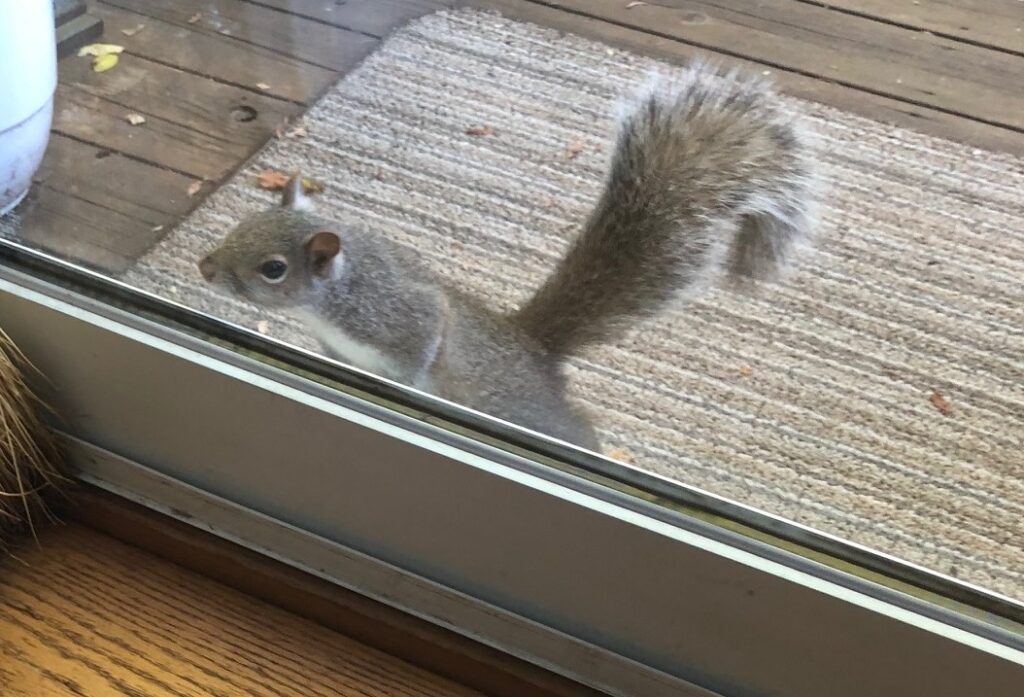
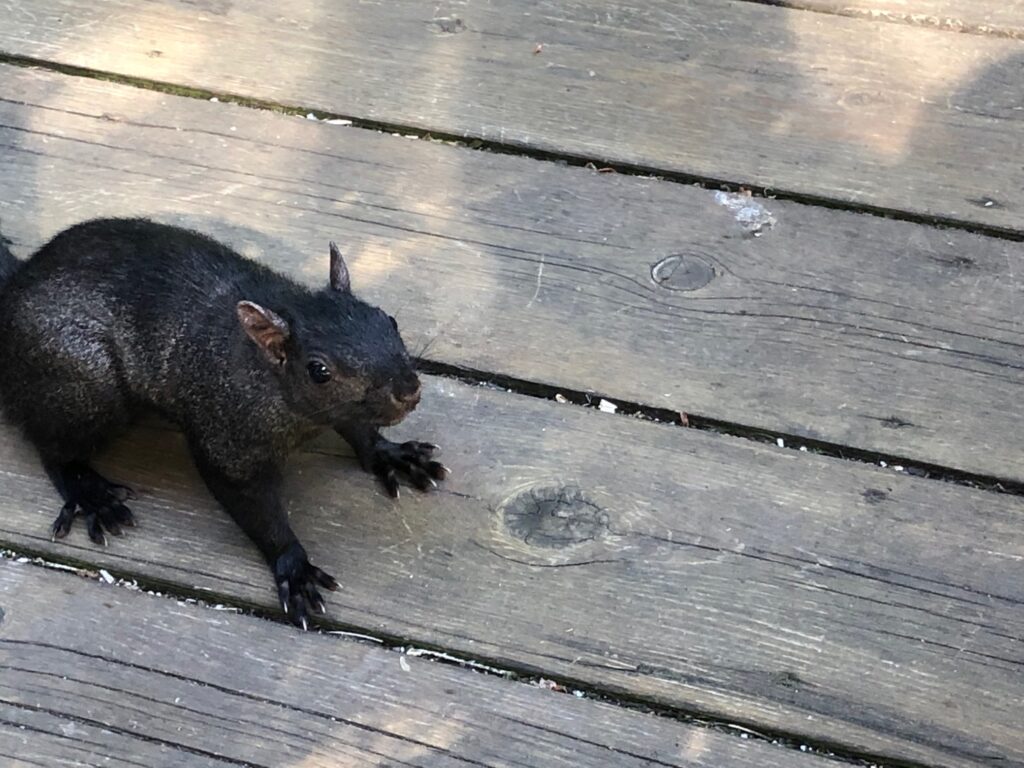
Photo by Heather Kelly.
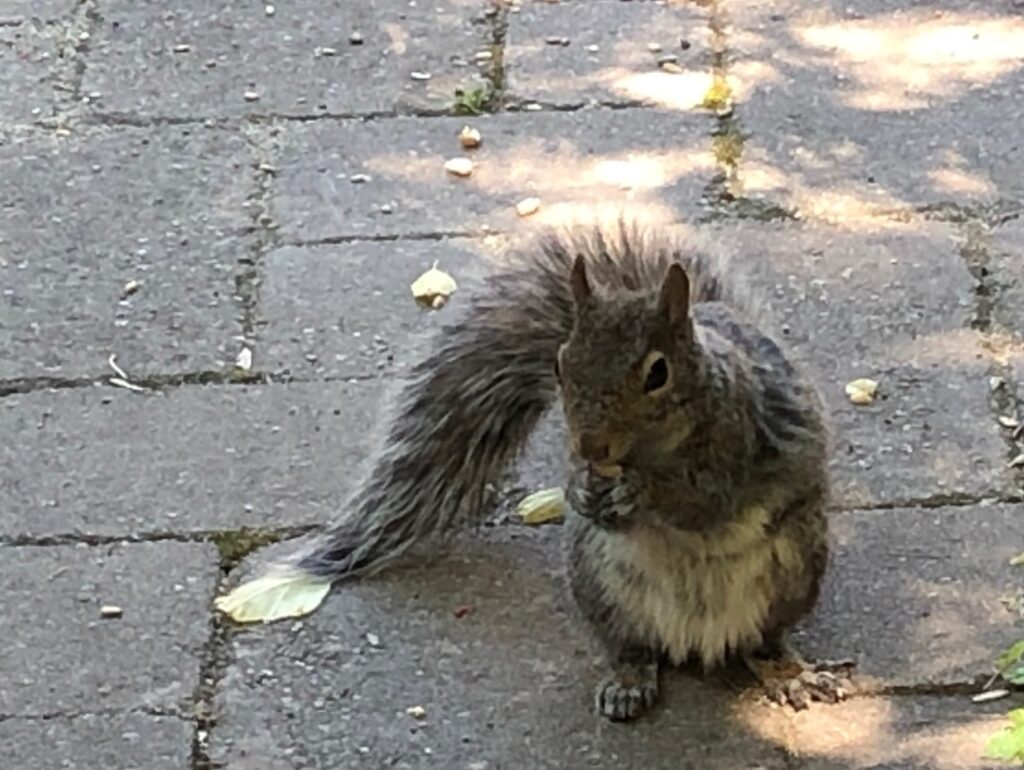
Photo by Heather Kelly.
Mimi’s Mama Vest
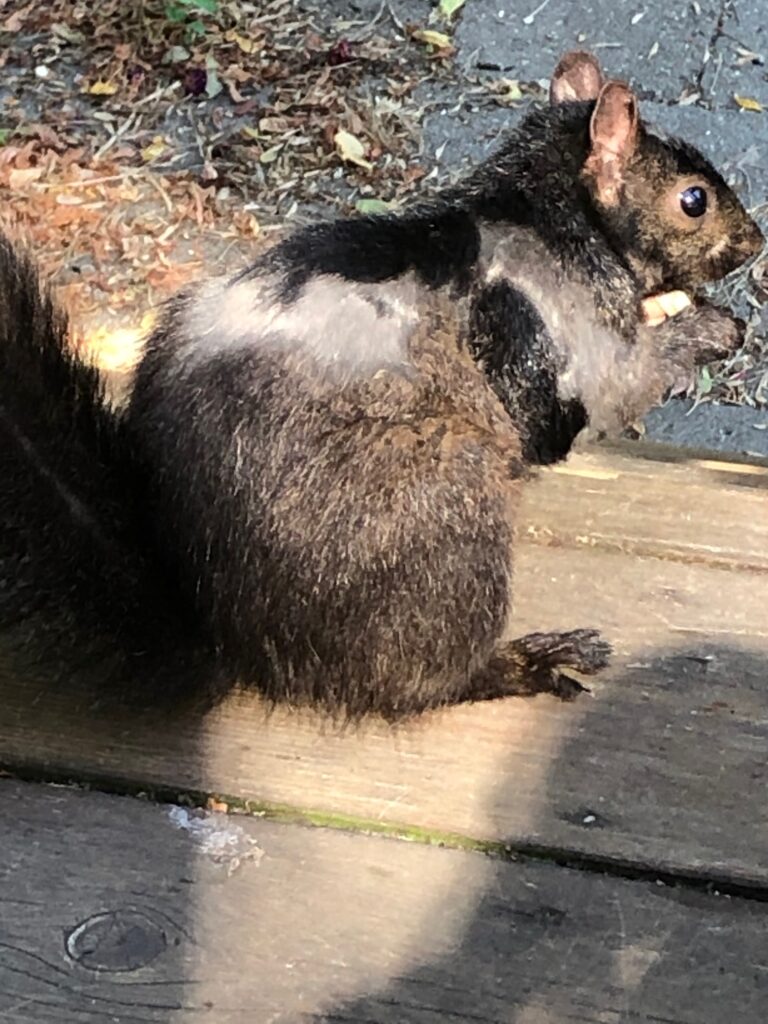
When I first met Mimi a few months ago (in my back yard), it was clear that she was a nursing mama. Her teets were obvious when she sat on her hind legs, bare of fur, and her body was larger than most of my other squirrel neighbours.
At first when I noticed her fur markings I wondered if she might have mange or a condition of some sort. But as I got to know her, and see her almost every day, it was clear she was healthy and mange free. She has a mama vest!
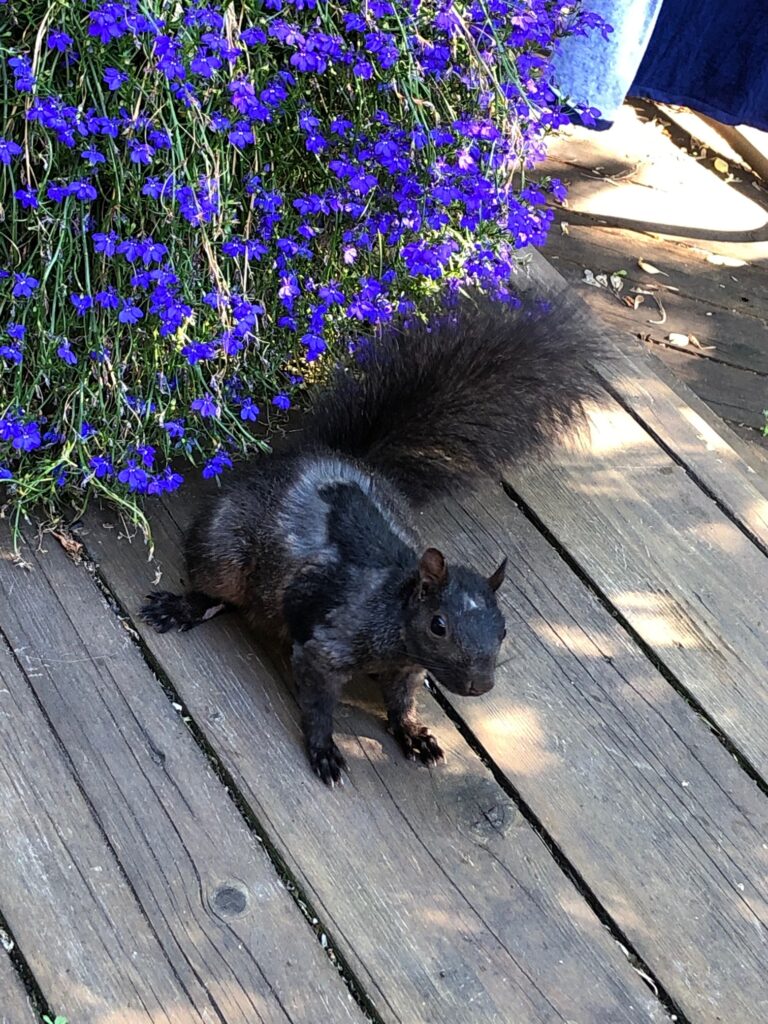
Mama squirrels pull out their own fur to line their nest. The fur ensures that their babies stay warm and dry on cold spring and autumn nights.
Think about that for a sec. Can you imagine pulling out your own body hair to line your baby’s crib?!?? Not just grooming ones self and saving what gets brushed out, but actually pulling out your own healthy fur. Wow.
So, of course, I looked into it. Do other animals do that, too? Sure, you might think of birds nests having feathers in it, but I would not have imagined that the birds pluck their own bodies to prep their nests. And what about other furry mammals, like raccoons, bears, coyotes, foxes, and skunks – do they pull out their own fur, too?
There appears to be a lot of info about pregnant bunnies pulling out their fur. Mostly from worried pet owners looking for advice. And there is info about the common mental health condition called trichotillomania, where humans and other animals pull out their own hair or fur due to stress and anxiety.
But there seems to be very little to no publicly available research about the phenomenon of pulling out ones own fur lovingly, instinctually, to prep to care for babies.
Apparently some birds will use brushed out dog or cat hair to line their nests, and some people put their pet hair brushings outside for the birds to use. (I never would have thought of that.)
If I come across more insight about it, I’ll share the info with you.
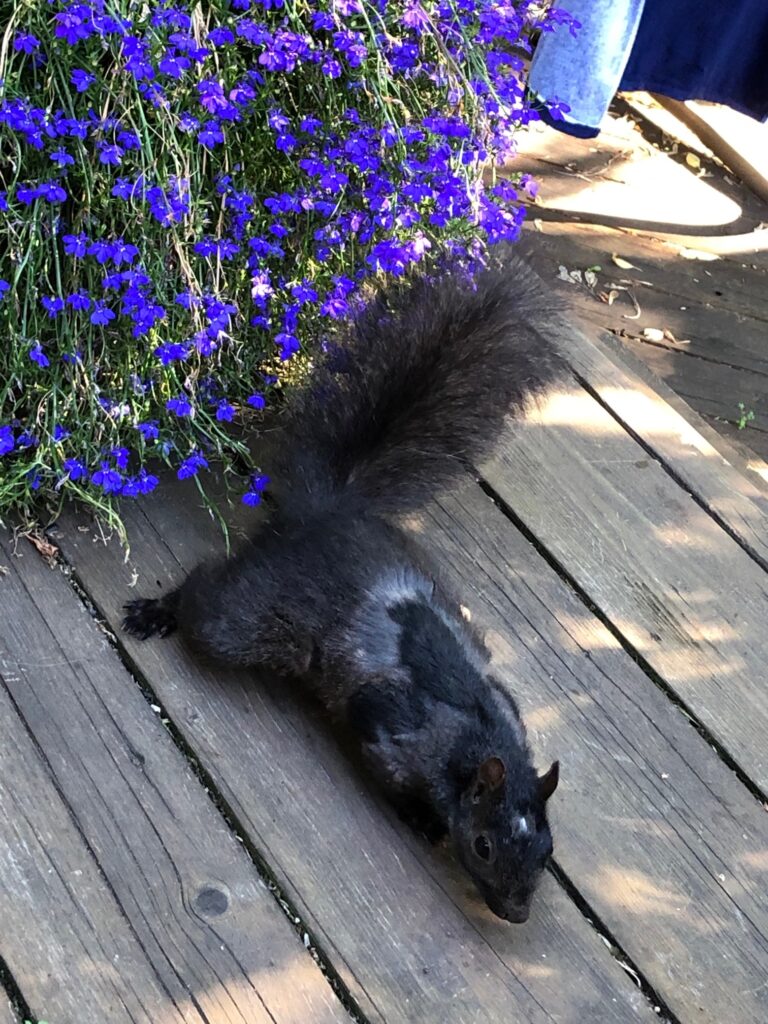
It was many weeks before I met Mimi’s babies, and then realized who is hers. The only way I can tell is that they romp around together and with her. All of the other squirrels are wary of each other and can be aggressive toward each other.
But Mimi and her babies – Baby Grey, Baby Brin, and the most recent one who I discovered is a sibling, Greysie – will tumble around with each other affectionately and playfully.
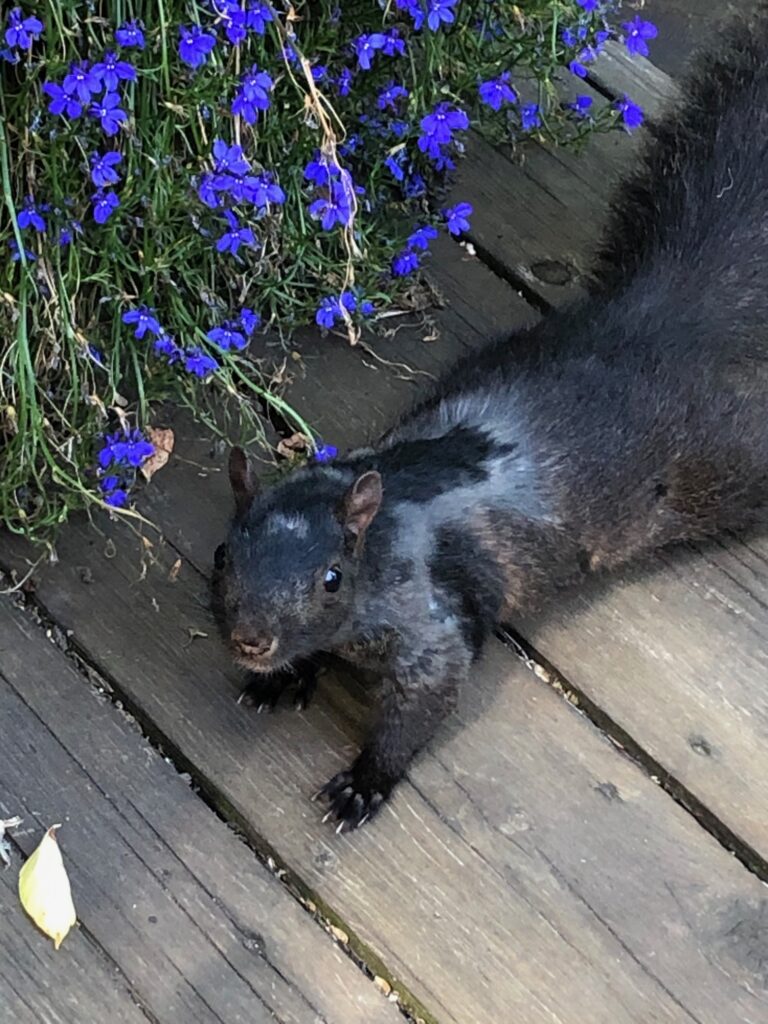
How Hot is it Today?
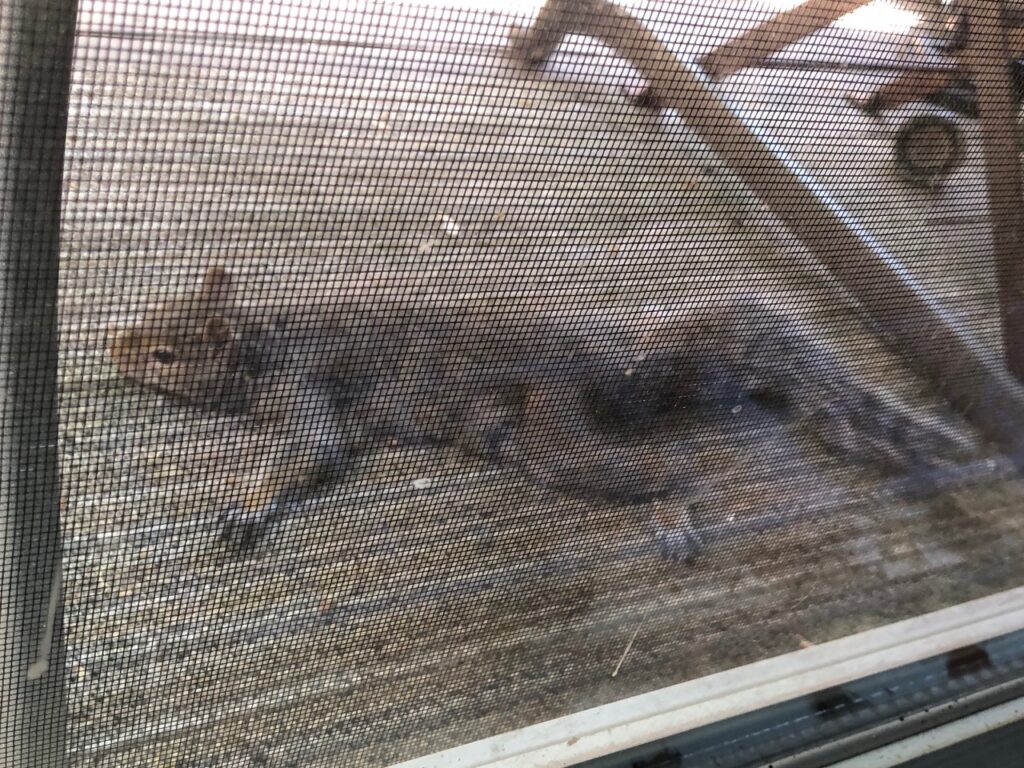
It’s somewhere around 30 degrees in Toronto this afternoon. My little friend Gradie is lying spread-eagle in the shade of a chair on my porch beside me as I work inside.
Yesterday he lay on his stomach in the shade on the driveway, all four legs straight out in each direction. And earlier today I saw another of my squirrel neighbours, Mimi, in the same position in my back yard.
Apparently, this is called “planking” or “heat dumping,” and, as you’d guess, it helps them cool down. The idea is to get as much of the surface of their tiny body against a cool surface, and this dissipates body heat.
DYK squirrels sweat through their feet?? I sure didn’t. They also pant like dogs and other animals. And they sometimes lick their fur so they can get a little cooler when it evaporates.
Squirrels can get heat stroke, like people, and it seems to happen primarily when the don’t have access to water. I have a small water dish out for my furry little neighbours.
Today’s small joy: my little garden ‘helpers’ ready to get to work
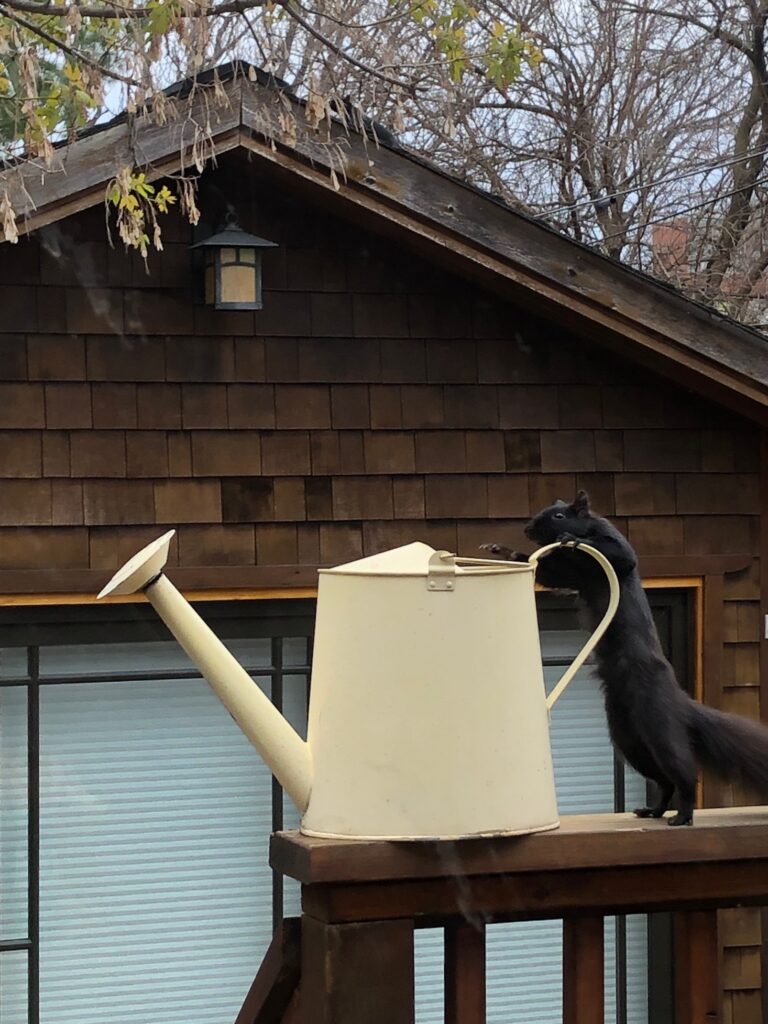
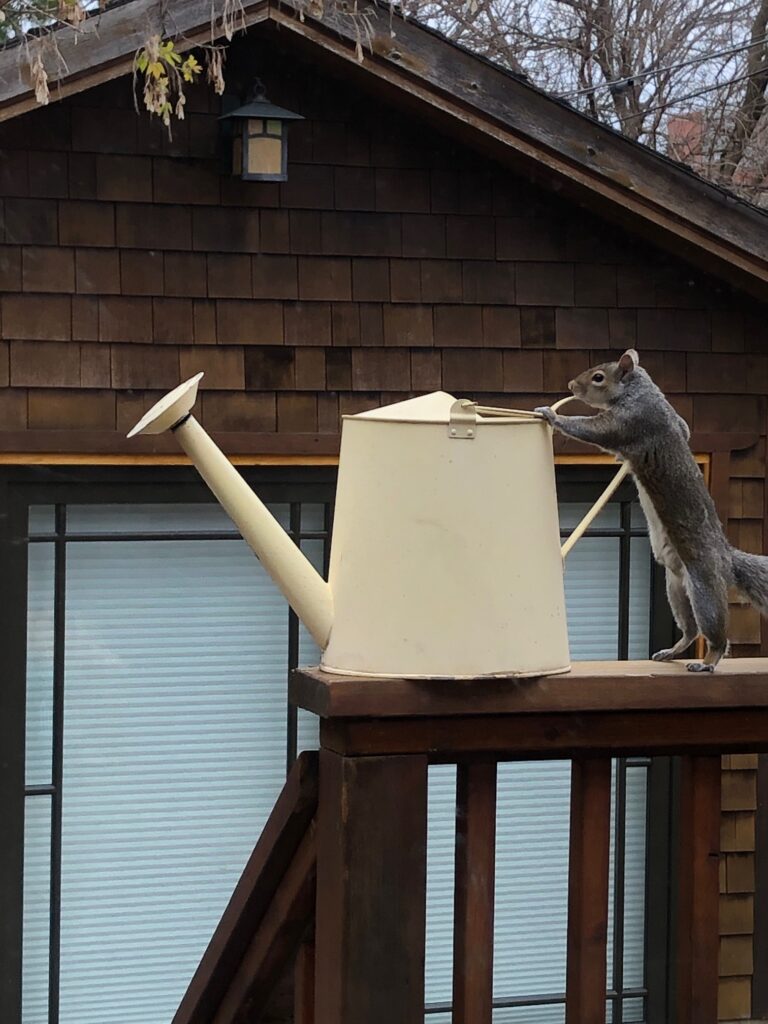
Today’s small joy: Tiny Batman Returns! (To fight crime on my back porch)
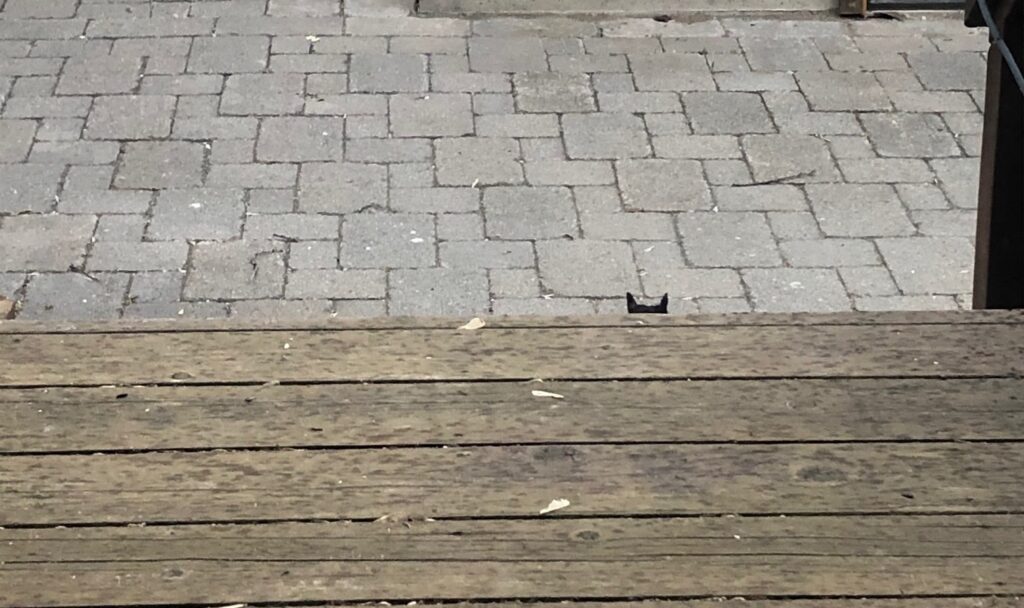
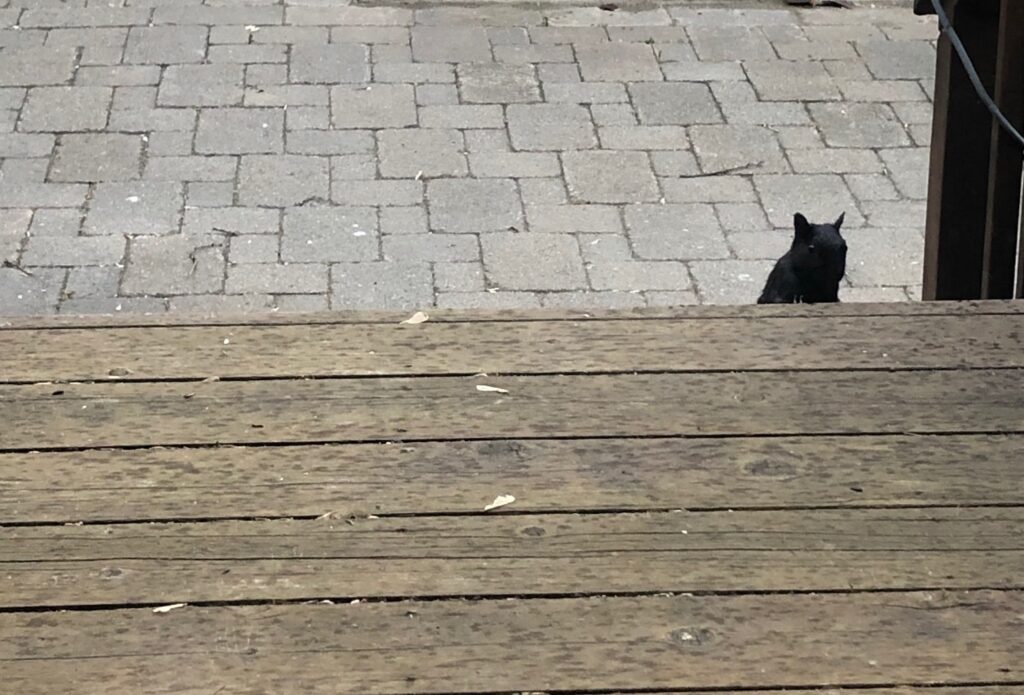
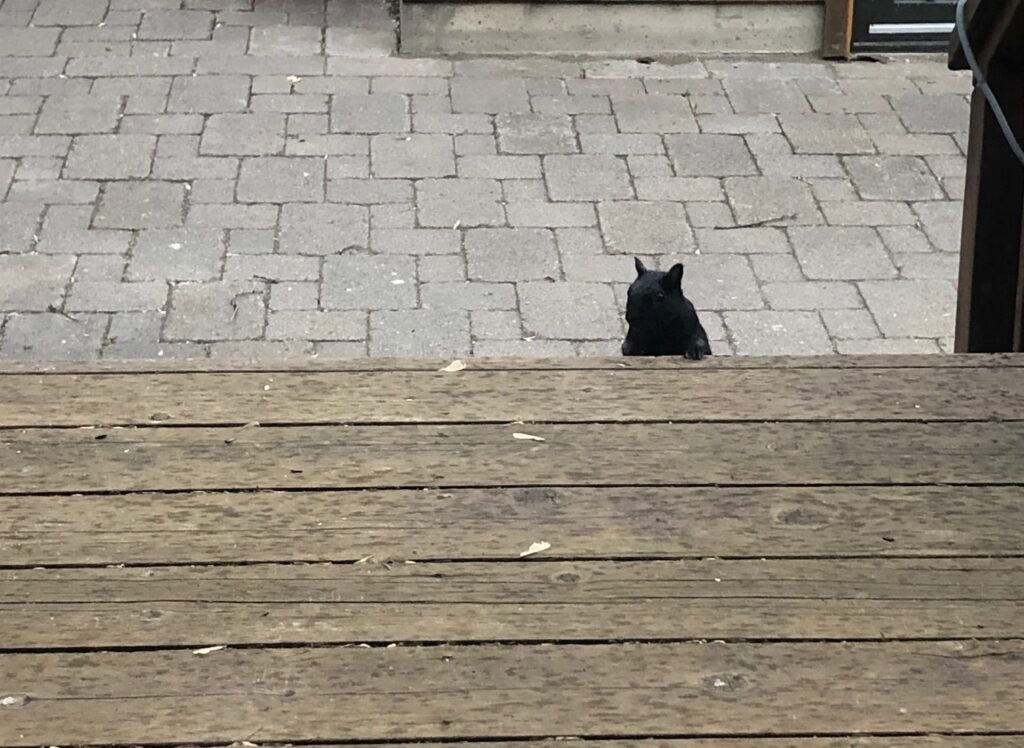
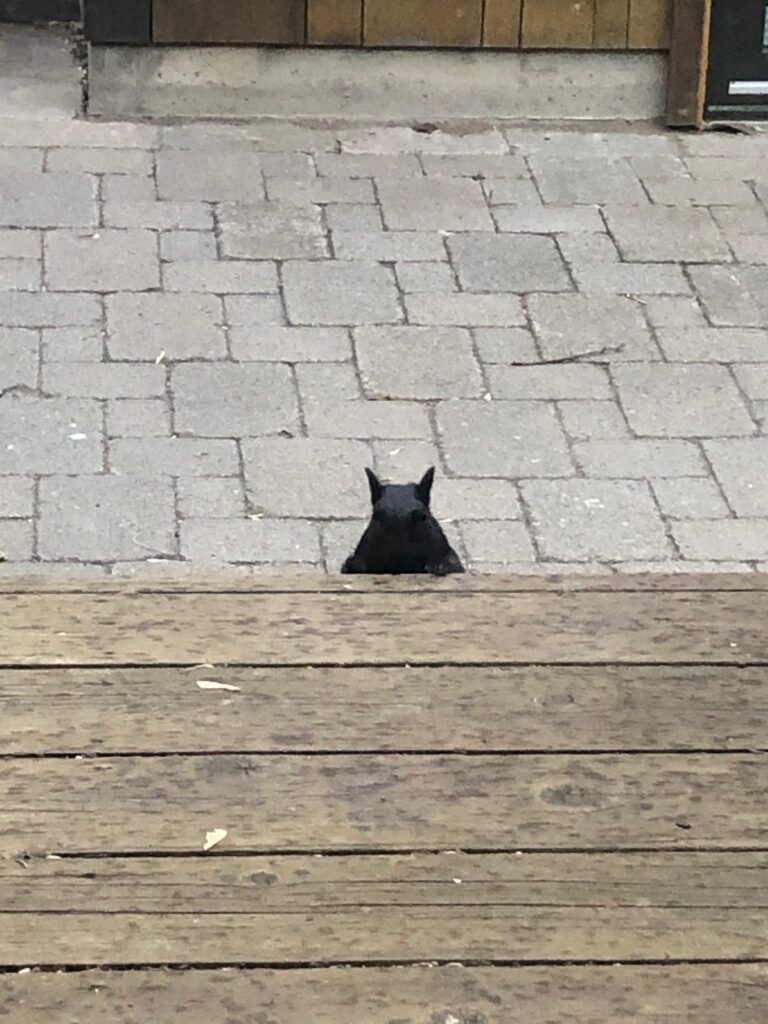
Cirque du Squirrel
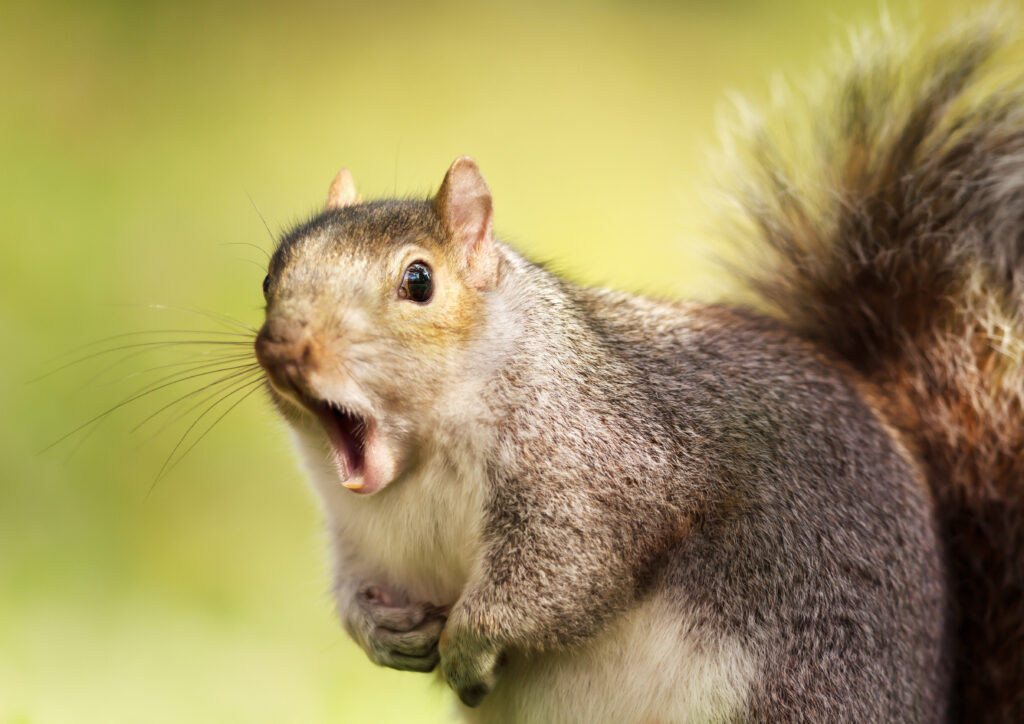
As soon as I arrived in the nursery room I was concerned about very loud, deep, growling and yelping. It was coming from one of the enclosures where there was also a lot more frenetic movement than usual. The vocals were coming from a grey squirrel. It was in an enclosure with a black squirrel who was hiding in a box.
I looked under the sheet covering the enclosure from time to time. Trying to figure out what was going on. The grey squirrel would climb quickly around the enclosure, and periodically stop on its back, fuzzy white and caramel-coloured belly exposed, growling loudly. I am not sure what kind of behaviour this is, but it is unsettling.
It seemed like it was being bullied or was bullying the other squirrel. I mentioned the very vocal sounds and strange physical behaviour to staff member CA. She told me that they had just been put into the same enclosure together and needed to get to know each other. I was scared they would stress each other out or kill each other before they settled in together as roommates!
In any case, the job at hand was to feed the babies in one enclosure, and clean two of the other enclosures in the room. I didn’t know the adventures that would unfold.
This late in the season, there is no nursery-specific shift at the TWC anymore. But there are still some squirrel babies who need to be fed formula. Right now there are only 4 squirrels who are fed 3x per day and one who is fed 2x per day.
I got formula from the fridge and was putting some into a smaller jar to heat up, as N, a very experienced nursery volunteer arrived.
Each of the four young squirrels was to be fed around 16-20cc of formula. Some were just not interested. They are squirmy, scratchy, and feisty. They might guzzle formula for a moment, then try to make a run for it. Or just wiggle away, into the pillowcase being used to hold them. But we managed to feed all of them the required amount of formula – it just took a while.
Sidenote: No matter how squirmy and feisty a baby squirrel may be, they almost always hold still when a warm damp scrap of paper towel is being used to wipe formula off their face, paws, belly and tail fur. (The formula will dry and pull out their fur, if not cleaned off.) I think this strange momentary stillness must be instinctual. The feeling is probably similar to the feeling of their mom squirrel licking them, which would happen naturally in the wild.
Then it was time to clean the other two enclosures, weigh and give medicine to the patients, and put them back into their main enclosures. These were not the babies, these were older juvenile squirrels, larger, and mind-boggling fast.
And two squirrels made a break for it! (To be fair, they all tried.)
There were four black squirrels in an enclosure on the other side of the room from the one where the squirrels to be fed were housed. These four were weaned and didn’t need to be fed, but they needed medication to be given to them orally. Tiny amounts, .06 and .07 CC, in tiny 1cc syringes. Two different meds each.
Staff member CA prepped the meds for N to administer. N organized each pair of syringes on each squirrel’s chart. N cleaned their main enclosure earlier, and the squirrels had been placed in a smaller temporary enclosure.
Since these squirrels are older, larger, and wilier, gloves are required to handle them. But the gloves are really awkward. Especially for small fine enclosure lock clasps or unhooking little claws.
I took the first squirrel out of the temporary enclosure, and N helped unhook its tiny claws from the wires. I held the squirrel for N to quickly give it the two oral medications. I then placed the squirrel in a large cardboard box that was on a small scale for it to be weighed.
Once weighed, I removed the box to near the squirrel’s enclosure. As I was unlocking the main enclosure’s opening, the squirrel escaped through a tiny hole that had been chewed through the top of the cardboard! And it was off!
First to the top and then behind the enclosure. Then it ran all over the room, under chairs and the table, and back to the area where its enclosure is. Where it found a little two or three-inch crawlspace below the enclosure where I couldn’t reach it. It got out from there and past us all again.
N and I had nets and tried to catch it as it ran all over the room. Finally, N got a net over it. As I was trying to remove the squirrel from the net, it escaped again! Ack!
And so we went through the whole thing again, until the squirrel was recaught in a net by N, and safely returned to its enclosure.
Needless to say the other three were brought out of the temporary enclosure, given meds, weighed, and returned to their large enclosure, all as quickly as possible. Less chance of escape!
That little black squirrel was not the only escape artist of the afternoon.
The other escapee was the grey squirrel who had been loudly growling and yelping and sprinting around its enclosure all afternoon.
As it was being moved from its enclosure temporarily, to be weighed as its main space was cleaned, whoosh! A quick aerialist move, and it was out!
Grab the nets again. More chasing and herding and crawling under the table – it was easy for the squirrel, not so easy for me. More squirrel antics. All in fast forward, it seems.
N was able to net the squirrel as it tried to race across the open floor. We did not trust that it wouldn’t escape from a cardboard temporary enclosure, so we placed it in a more secure wire enclosure until its main space was finished being cleaned. Its roommate also needed to be removed for the enclosure to be cleaned, and it also needed to be weighed.
So I caught on. As we were waiting for another volunteer to finish cleaning that enclosure, I placed a net over the cardboard box that the last squirrel was being held in. It chewed right through the top of the box and leapt out. Ha! Into the net!
So we gently placed the squirrel back the box. And covered the top tightly with a pillowcase. It’s not easy to outsmart a small Houdini of a squirrel! Contortions that a Cirque du Soleil performer would envy, smarts of a fox, and speed – that supercrazyfast squirrel speed.
When the squirrel escaped the box again, it went right into the pillowcase. I took the pillowcase end off the box, twisted the top closed, and held it tightly. The squirrel was now in the pillowcase, on the table.
It twirled and turned and scratched and leapt! But I was holding the pillowcase closed. I was ensuring that the squirrel didn’t bash itself into anything (like the scale or the formula heater), and that it was safe from falling off the table as it did acrobatics in the pillowcase.
As soon as its enclosure was clean, with fresh food and water placed in, we could return the final two squirrels. This one in the pillowcase was easy. I could gently place the whole pillowcase in the enclosure and open it up for the little one to leap out of.
Returning the other one – the lightning fast growly wily grey squirrel – was another story. (BTW, it had been perfectly calm and quiet, as far as squirrels go, the whole time it was alone in its smaller temporary enclosure.)
I didn’t trust that it wouldn’t pull another stunt move and escape again. This time I lifted the whole temporary enclosure and placed its opening against the opening of the main enclosure, to return the squirrel directly. Do not pass go, no human handling, nor any space tempting to squeeze through.
Funny thing was, it was in no hurry! I think it found remains of formula on my shirt to lick, which it was more interested in than going back into its larger enclosure. So it took a little gently coaxing and we finally got it back into its enclosure. Whew.
Later in the afternoon, we were back in the nursery for the final round of feeding for the day. I was reaching into the enclosure to bring out one of the baby squirrels to feed again. One of the branches in the enclosure was in the way, and it was loose. The branch was about 18 inches long, like a tiny tree trunk.
I ended up bring out a squirrel – holding on to the vertical branch for dear life. I was holding on to her from the back. She had all four arms, legs, and paws wrapped around the branch and was holding it tight to her chest, with her little head to one side to see around it.
I showed N and we both had a smile. You never know when these little patients will melt your heart. We then finished feeding everyone their formula for the evening.
At the end of the night, N told me about her wonderful Instagram account @nickisimms. It is full of photos and videos of animals at sanctuaries, around the city, and her sweet creatures at home. Check out @nickisimms – it’s awesome.
